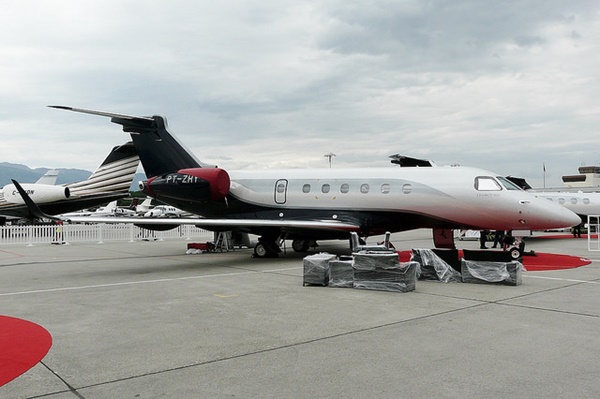FAA certificated Legacy 500 beats performance expectations
Legacy 500 in flight
Embraer’s newly FAA certificated Legacy 500 has beaten many of its performance targets in key areas.
The Legacy 500 has finally crossed the certification finishing line, with the aircraft meeting, and in some cases exceeding, performance expectations.
ALSO SEE: Embraer’s Legacy 500 gets certificated in Brazil
Embraer first spoke about the then unnamed Legacy 500 during the 2007 NBAA show, where it unveiled its concepts for aircraft that were then called the MSJ (Mid-size Jet) and MLJ (Mid-light Jet).
The MSJ and MLJ concepts that Embraer presented were clean sheet designs, with the Brazilian airframer designing both aircraft to become the ‘best in class’ in the space that they intended to compete in.
Both aircraft would share a six foot stand up fuselage cross section, have the same Honeywell HTF7500E engines, the same Rockwell Collins Pro Line Fusion avionics and, for the first time for Embraer, both aircraft would use fly-by-wire control systems.
In keeping the MSJ and MLJ as common to each other as possible, Embraer stated that they would keep the costs of the programs to $750 million, and secure a common pilot type rating for both aircraft.
Although both aircraft were still in the concept stage at the time of the NBAA, Embraer took a full size cabin mock-up of the MLJ to the Atlanta show, intending to get feedback from potential customers before presenting the concepts to the board for approval.
The board, keen to expand the company’s business aviation offering, were obviously impressed by what they saw and gave the go-ahead for both aircraft on 28 March 2008.
Embraer formally announced both aircraft the following month, but it was May’s EBACE that saw the aircraft introduced to the world, with both aircraft now sporting proper names.
Rather than keeping in-line with the Phenom family name, Embraer had decided to associate the new aircraft with the Legacy family, giving the aircraft a more prestige feel of the larger aircraft than the smaller Phenom’s.
Intended to enter service in 2012, Embraer renamed the MSJ to the Legacy 500, while the MLJ that was due to enter service a year later, had been named the Legacy 450.
Embraer’s original timeline for the Legacy 500 called for certification in late 2012 and customer deliveries to begin shortly afterwards.
But in 2011 Embraer hit a snag with the software that controls the fly-by-wire technology that the Brazilian airframer was working with for the first time. Blamed on Parker Aerospace, the issues would cause a one-year delay to both the Legacy 500 as well as the Legacy 450.
A further delay was announced in 2013, although Embraer wouldn’t cite any specific reasons.

Eventually, the Legacy 500 flew for the first time on 27 November 2012, although Parker would later tell AIN that the aircraft flew without full fly-by-wire functionality.
The major area where the Embraer 500 beat its design goals is with the engines, where the twin Honeywell HTF7500E Turbofans saw a 7.5 per cent increase in individual thrust from 6,540 lb to 7,036 lb.
These help Embraer beat take-off distance and un-factored landing distance projections by over 11 per cent, and also helps boost the range by 4.1 per cent.
One of the most significant increases though is with the hot and high performance of the engine flat ratings, where engineers have improved on the the original ISA (International Standard Atmosphere) +15 degrees Celsius target by three degrees.
While three degrees may not seem too significant, it means that the aircraft can be operated at design specification at airports that are high above sea level.
“We are thrilled with the achievement of the Legacy 500 certification, a revolutionary jet that delivers true innovation to our customers,” said Frederico Fleury Curado, president and CEO of Embraer. “I want to congratulate our teams for their passion and their dedication to bring to market this extraordinary aircraft.”








